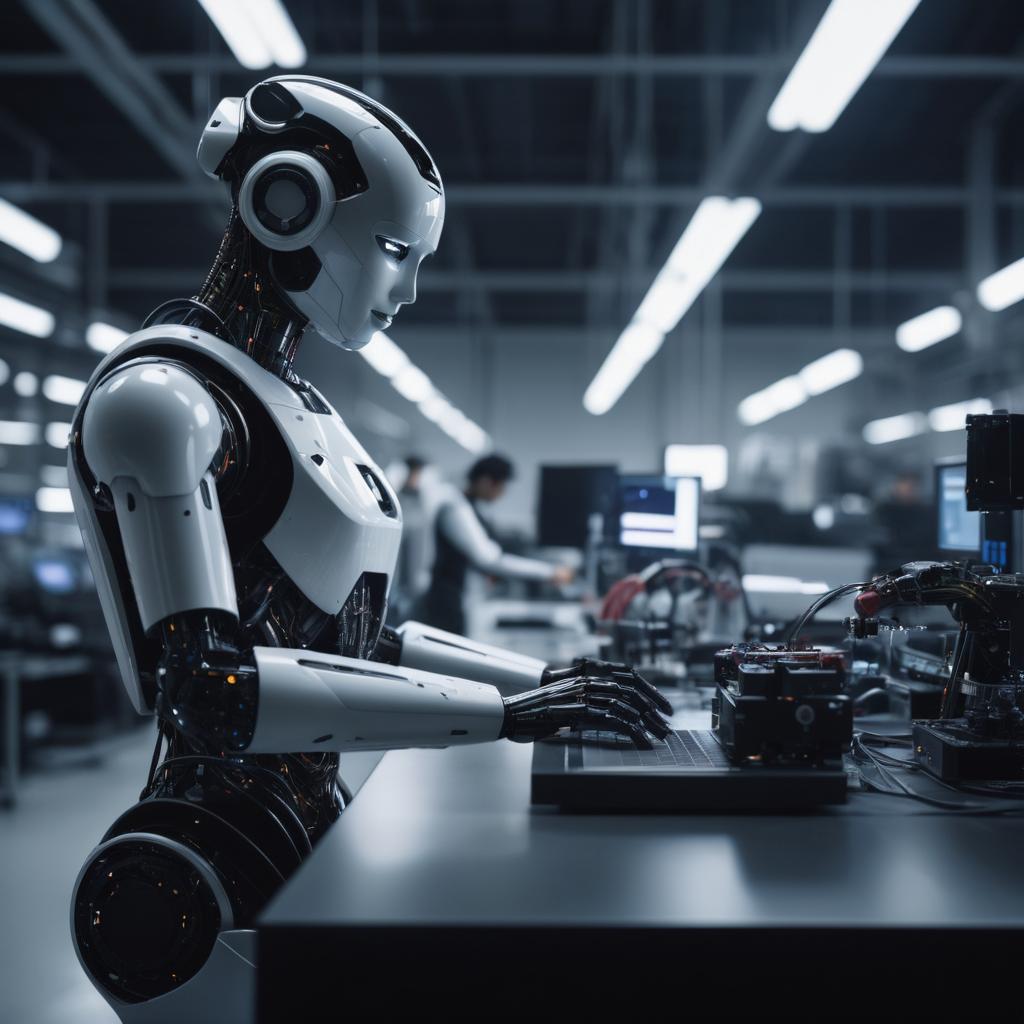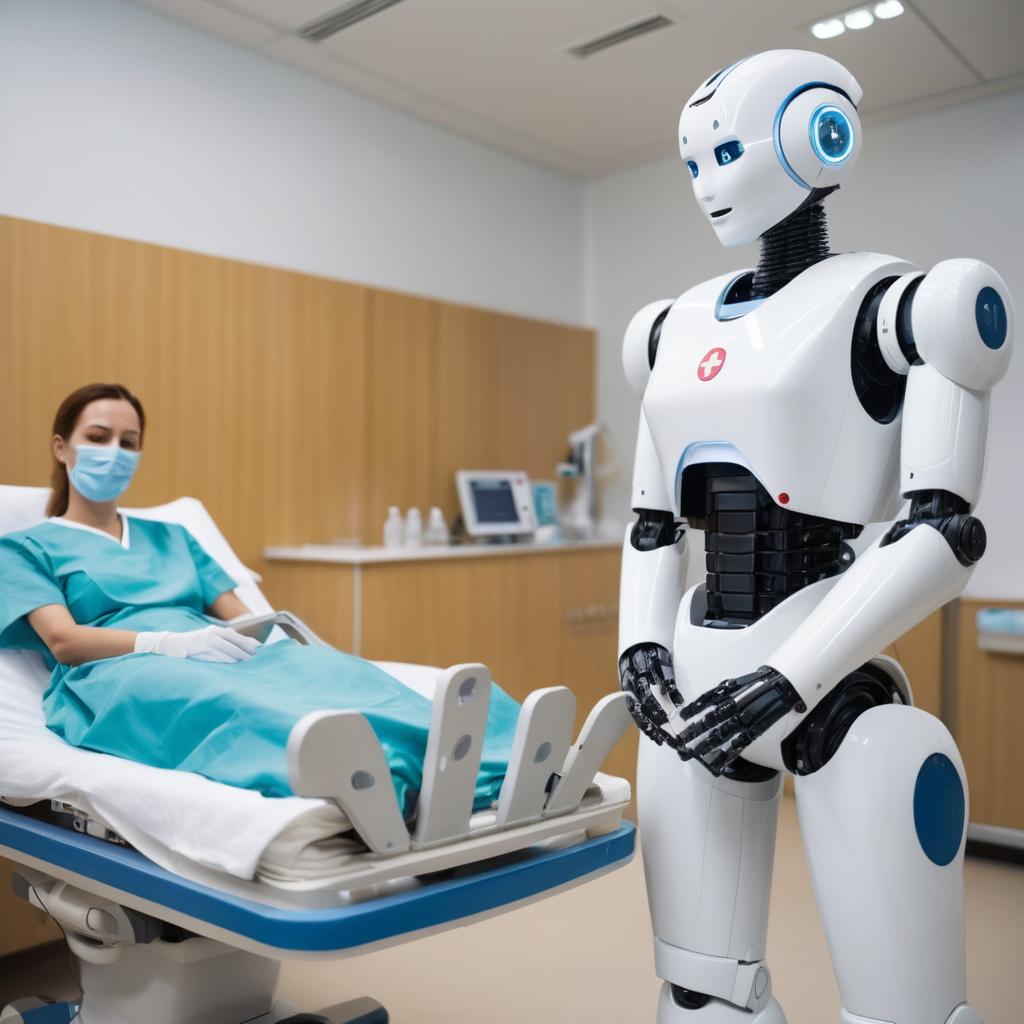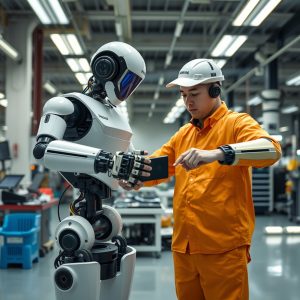
Robotics and Artificial Intelligence (AI) are two rapidly evolving technologies that are set to transform numerous industries. As the lines between these fields blur, the robotics industry is adapting to the ongoing revolution in AI to deliver innovative solutions with higher levels of autonomy and intelligence.
In manufacturing, robotic systems equipped with advanced AI capabilities enable factories to operate more efficiently and cost-effectively by automating complex tasks such as quality control, material handling, and assembly. For instance, collaborative robots or “cobots” can work alongside human operators, enhancing productivity while minimizing the risks associated with traditional industrial robots.
How robots manufacturers are adapting.
As someone who has been closely following the developments in the field of artificial intelligence and robotics, I am excited to see how Scottish tech firm Robotical is adapting its educational robot designs to reflect the ongoing revolution in AI. The company’s founder, Sandy Enoch, highlights that “the AI revolution is changing everything” and this statement could not be more true.
The use of intelligent machines has already made a significant impact on various industries such as manufacturing, healthcare, and education. Robotical’s new generation of robots, which incorporate machine learning and advanced data processing capabilities, allow them to perform tasks autonomously or with minimal human intervention. This development is in response to the growing demand for intelligent machines in these industries.
In the manufacturing sector, AI-enabled robots are being used to automate processes, reduce production costs, and improve quality control. In healthcare, AI-powered robots are being deployed to assist doctors and surgeons in diagnosis and treatment planning. In education, educational robots are being used to help students learn complex concepts in a more interactive and engaging way.
However, as the use of AI continues to expand, it is crucial that we address the potential risks associated with intelligent machines, such as job displacement and privacy concerns. It is essential that companies like Robotical prioritize the development of responsible AI technologies that consider these issues and ensure that they are being used in a way that benefits society as a whole.
In terms of future developments, I believe we will see a dramatic increase in the number of smaller start-ups emerging from this revolution, particularly in the area of robot companions. This is due to the growing availability of affordable 3D printing technology, locally LLM models, and advances in vision and speech recognition that are connecting with advanced robotic mechanisms.
The paradigm change – from programming to learning robots
The current approach to programming robots involves tedious sequence-based instructions, which requires extensive knowledge and expertise. This traditional paradigm has limitations as robots fail to adapt to unexpected changes in their environment or interact with unknown objects. However, a new paradigm shift in robotics is underway, focusing on developing robots that are self-aware and can intuitively understand the world around them.
By doing so, these robots will be able to adjust their behavior without requiring constant reprogramming, making them much more versatile and useful for various applications. This approach is similar to how humans learn through experience and interaction with objects in the environment. The ultimate goal of this paradigm shift is to create robots that can perform tasks autonomously and efficiently, enabling a range of new and exciting possibilities in fields such as manufacturing, healthcare, and transportation.
Researchers at MIT’s Computer Science and Artificial Intelligence Laboratory (CSAIL) have developed a system that enables robots to learn how to touch and feel objects by simply looking at them. Using a tactile sensor and web camera, the team created a dataset called “VisGel” containing over 3 million visual-tactile paired images of nearly 200 objects being touched more than 12,000 times. By feeding this data into their system, which uses generative adversarial networks (GANs), the researchers were able to train it to both predict where a touch would occur and what shape or material was present in that area. This technique has several practical applications for robots, such as improving grasping abilities and reducing the amount of data needed for tasks involving manipulation and object recognition. The system is also capable of predicting which object and part are being touched directly from tactile inputs, allowing robots to better understand interactions between vision and touch, particularly in unstructured areas or when objects are obscured.
OpenAI, the creator of popular AI language model ChatGPT, is partnering with robotics startup Figure to bring its advanced artificial intelligence systems into humanoid robots for the first time. The collaboration will involve OpenAI building customised AI models for use in Figure’s robots, accelerating its commercial rollout by enabling them to process and reason from spoken language. Figure has raised $675m (£521m) from investors including Amazon’s Jeff Bezos and Microsoft’s venture capital arm M12. The humanoid robotics market is still in the early stages of development, with many robots employed in factory tasks having animal-like features rather than human shapes due to difficulties in developing effective legs and arms. OpenAI chief executive Sam Altman admitted the company had begun research into robotics too early in the past, leading to a hiatus in its robotics programme as it struggled with “broken tendons”. However, he suggested that AI was becoming increasingly important for physical tasks, allowing robots to do work that humans did not want to carry out due to a shortage of staff.
The collaboration between OpenAI and robotics startup Figure will have a significant impact on the development of robots in everyday life. The partnership will involve OpenAI building specialized AI models for Figure’s humanoid robots, which will allow them to process and reason from language. This will accelerate Figure’s commercial timeline by enabling its robots to perform tasks that humans are not willing to do due to a shortfall of labor.
The use of AI-powered humanoid robots has the potential to revolutionize many fields, from healthcare and education to manufacturing and logistics. As these robots become more sophisticated and affordable, they will likely become a common sight in everyday life, making our interactions with technology even more seamless and intuitive.
Impact of AI revolution into industries
it’s impacting various industries such as manufacturing, healthcare, education and transportation in significant ways.

In manufacturing, the integration of AI-powered robots has led to increased efficiency and productivity. By utilizing machine learning algorithms and advanced data processing capabilities, these robots can analyze and interpret vast amounts of data, which in turn enables them to carry out tasks autonomously or with minimal human intervention. This technology also allows for greater flexibility in manufacturing processes as robots are able to adapt to new situations and work alongside human operators.
The implementation of AI-powered robots also has positive environmental impacts. By utilizing advanced algorithms to optimize resource usage and minimize waste, these robots can significantly reduce the carbon footprint of manufacturing operations. For example, some factories are now using AI to monitor energy consumption and adjust production schedules accordingly, resulting in significant energy savings and lower greenhouse gas emissions.
In conclusion, the integration of AI-powered robots into manufacturing processes has led to numerous benefits, including increased efficiency, productivity, safety, cost savings, and environmental sustainability. As this technology continues to advance and become more widely adopted, it is likely that we will see even greater transformations in the way we produce goods and services in the future.

In the healthcare industry, AI-powered robots have already made a considerable difference in improving patient outcomes by providing personalized medical care. These robots can assist doctors in making accurate diagnoses, analyze complex medical data, and even perform surgeries with greater precision and accuracy than human surgeons alone.
The global market for medical robots is projected to reach $9 billion by 2024, according to a report by Grand View Research. This growth is driven by the increasing demand for minimally invasive surgeries and the aging population. As our society ages, there will be a greater need for AI-powered medical robots to provide elderly patients with more personalized and effective healthcare solutions.
Moreover, these robots have been shown to significantly reduce recovery times, which can lead to lower overall healthcare costs. In turn, this makes AI-powered medical robots an attractive investment for hospitals and healthcare providers looking to improve the quality of care they provide while managing their budgets more effectively.
In addition to the benefits that AI-powered robots offer to patients and healthcare providers alike, there are also potential drawbacks that need to be addressed.

In transportation and logistics the development of more autonomous robots with AI capabilities without the need for programming is set to significantly impact the transportation and logistics industry.
Self-driving cars, for instance, are a prime example of how autonomous robots with AI capabilities will replace traditional driving positions. These vehicles can navigate roads independently without human intervention, which could potentially eliminate millions of driving jobs worldwide. According to a study by the McKinsey Global Institute, self-driving trucks could displace up to 3 million trucking jobs globally by 2030.
Similarly, automated warehouses and packing facilities will also replace traditional warehousemen and packers positions. Robotics technology has advanced enough that machines can now handle the entire process of picking, sorting, and packing products with greater speed, accuracy, and efficiency than human workers. According to a report by CB Insights, automation in retail is expected to eliminate up to 70% of jobs in warehouses and distribution centers by 2035.

In education, AI-powered robots are being used as teaching tools to help students learn in a more interactive and engaging way. These robots can provide instant feedback on student performance, explain complex concepts, and even assist with language learning. As AI technology continues to evolve, it’s likely that we will see more applications of AI-powered robots in education, including virtual tutoring and personalized learning experiences.Moreover, AI-powered robots can help bridge the achievement gap by identifying areas where students struggle and providing targeted interventions. For example, a robot could offer extra practice exercises to a student who is struggling with a particular math concept, or it could provide visual aids and simulations to help a student understand a complex scientific concept. These adaptive learning experiences can also be designed to be more engaging and interactive than traditional textbook-based learning, which can make learning more enjoyable and effective for students.
Another promising application of AI-powered robots in education is virtual tutoring. This technology enables students to connect with a digital tutor who can answer their questions, provide feedback on assignments, and offer guidance on academic topics. Virtual tutors can also be available 24/7, which can be especially beneficial for students who live in rural areas or have limited access to traditional tutoring services.
As for the future, it’s clear that AI-powered robots will continue to play an increasingly important role across a range of industries. The possibilities are endless, from self-driving cars and smart cities to more advanced medical procedures and customized education programs. However, there are also concerns around job displacement and privacy as these technologies become more sophisticated. It’s therefore crucial that we continue to explore the potential benefits and drawbacks of AI-powered robots, and ensure that they are developed in a responsible and ethical manner.
Development boost in robotics – more start-ups
As the field of robotics continues to evolve, Invenio sees a great future where 3D printing, local language models (LLM), vision and speech recognition technologies will revolutionize the industry.
These advancements will enable smaller start-ups to enter the market with affordable, customizable robot companions that compete with established players like Boston Dynamics.
The potential for 3D printing in robotics is immense. With this technology, robots can be built using a variety of materials, including metals, plastics, and even biodegradable materials. This means that manufacturers can create customized, lightweight robot components on-site, eliminating the need for expensive shipping costs and reducing the overall cost of production.
Large Language Models (LLM) run locally are another game-changer in the world of robotics. These models are trained on specific data sets and can make decisions based on that information without needing to be connected to a central server. This makes LLMs ideal for use in robots operating in remote or low connectivity areas, where traditional cloud computing solutions may not be practical or may be controversial due to the privacy concerns.
Vision and speech recognition technologies are also becoming increasingly sophisticated, allowing robots to better understand their environments and interact with humans more effectively. This means that robots can perform complex tasks with greater accuracy and efficiency, while also providing a more intuitive user experience.
Advanced robotic mechanisms will further enhance the capabilities of these new robot companions. For example, soft robotics technology allows for the creation of pliable, human-like appendages that can manipulate objects with greater dexterity than traditional rigid robot arms. This opens up a wide range of applications, from medical procedures to manufacturing tasks.
Invenio predicts that this emerging new reality will lead to an explosion in the number of smaller start-ups entering the robotics industry. These companies will be able to take advantage of affordable, customizable solutions powered by 3D printing, LLM models, vision and speech recognition technology, and advanced robotic mechanisms to create unique and innovative products. This will drive competition and innovation in the market, ultimately benefiting consumers with a wider selection of high-quality, cost-effective robot companions.
As we look towards this future, it’s clear that the possibilities for robotics are truly limitless. With advances in technology continuing to accelerate at an unprecedented pace, we can expect even more exciting developments on the horizon. It’s an exhilarating time to be involved in this industry, and Invenio is proud to be a part of it.







Wow, I’m truly amazed by the revolutionary advancements being made in robotics and AI! As someone who’s passionate about telemarketing, I can appreciate the efficiency and productivity gains that these technologies are bringing to various industries. The idea of robots working alongside humans to enhance productivity while minimizing risks is a game-changer.
As an expert in my own field, I’d like to add some additional insights from my experience as a telemarketer. When it comes to interacting with customers, AI-powered chatbots have been a huge help in handling routine inquiries and freeing up human agents for more complex tasks. However, I believe that there’s still a place for human empathy and personalization in customer service.
In terms of future developments, I agree that we’ll see a surge in the number of smaller start-ups emerging in the robotics industry. With advancements in 3D printing, LLM models, vision and speech recognition technologies, and advanced robotic mechanisms, it’s becoming more accessible for companies to create innovative products at an affordable cost.
One area where I think AI-powered robots will have a significant impact is in education. As you mentioned, these robots can provide instant feedback on student performance, explain complex concepts, and even assist with language learning. This could be especially beneficial for students who require extra support or have limited access to traditional tutoring services.
However, as we continue to develop these technologies, it’s essential that we prioritize responsible AI development and address concerns around job displacement and privacy. By doing so, we can ensure that the benefits of these technologies are shared by all stakeholders, including workers, customers, and society as a whole.
Overall, I’m thrilled to see where this revolution in robotics is taking us!